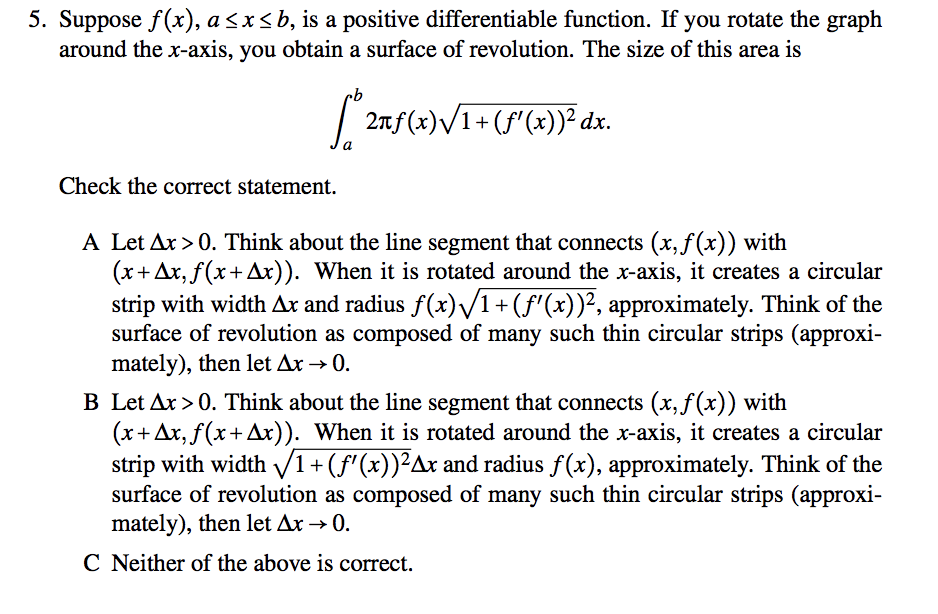Suppose f(x), a sxsb, is a positive differentiable function. If you rotate the graph around the x-axis, you obtain a surface of revolution. The size of this area is | 2nf(x)/1+(f'(x))² dx. Check the correct statement. A Let Ax > 0. Think about the line segment that connects (x,ƒ(x)) with (x+Ax, f(x+Ax)). When it is rotated around the x-axis, it creates a circular strip with width Ax and radius f(x)v1+(f'(x))², approximately. Think of the surface of revolution as composed of many such thin circular strips (approxi- mately), then let Ax → 0.
Suppose f(x), a sxsb, is a positive differentiable function. If you rotate the graph around the x-axis, you obtain a surface of revolution. The size of this area is | 2nf(x)/1+(f'(x))² dx. Check the correct statement. A Let Ax > 0. Think about the line segment that connects (x,ƒ(x)) with (x+Ax, f(x+Ax)). When it is rotated around the x-axis, it creates a circular strip with width Ax and radius f(x)v1+(f'(x))², approximately. Think of the surface of revolution as composed of many such thin circular strips (approxi- mately), then let Ax → 0.
Intermediate Algebra
10th Edition
ISBN:9781285195728
Author:Jerome E. Kaufmann, Karen L. Schwitters
Publisher:Jerome E. Kaufmann, Karen L. Schwitters
Chapter8: Conic Sections
Section8.2: More Parabolas And Some Circles
Problem 63.1PS
Related questions
Question

Transcribed Image Text:5. Suppose f(x), a < x < b, is a positive differentiable function. If you rotate the graph
around the x-axis, you obtain a surface of revolution. The size of this area is
| 2nf(x)V/1+ (f'(x))² dx.
Check the correct statement.
A Let Ax > 0. Think about the line segment that connects (x, f(x)) with
(x+Ax, f(x+Ar)). When it is rotated around the x-axis, it creates a circular
strip with width Ar and radius f(x)/1+ (f'(x))?, approximately. Think of the
surface of revolution as composed of many such thin circular strips (approxi-
mately), then let Ax → 0.
B Let Ax > 0. Think about the line segment that connects (x, f(x)) with
(x+ Ax, f(x+Ax)). When it is rotated around the x-axis, it creates a circular
strip with width V1+(f'(x))²Ax and radius f(x), approximately. Think of the
surface of revolution as composed of many such thin circular strips (approxi-
mately), then let Ax → 0.
C Neither of the above is correct.
Expert Solution
This question has been solved!
Explore an expertly crafted, step-by-step solution for a thorough understanding of key concepts.
Step by step
Solved in 3 steps with 3 images

Knowledge Booster
Learn more about
Need a deep-dive on the concept behind this application? Look no further. Learn more about this topic, advanced-math and related others by exploring similar questions and additional content below.Recommended textbooks for you

Intermediate Algebra
Algebra
ISBN:
9781285195728
Author:
Jerome E. Kaufmann, Karen L. Schwitters
Publisher:
Cengage Learning

Intermediate Algebra
Algebra
ISBN:
9781285195728
Author:
Jerome E. Kaufmann, Karen L. Schwitters
Publisher:
Cengage Learning